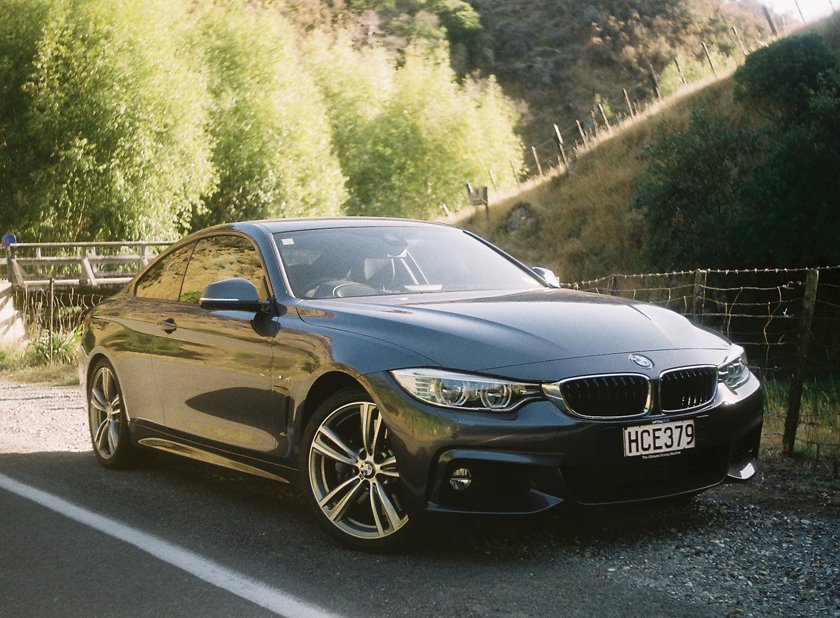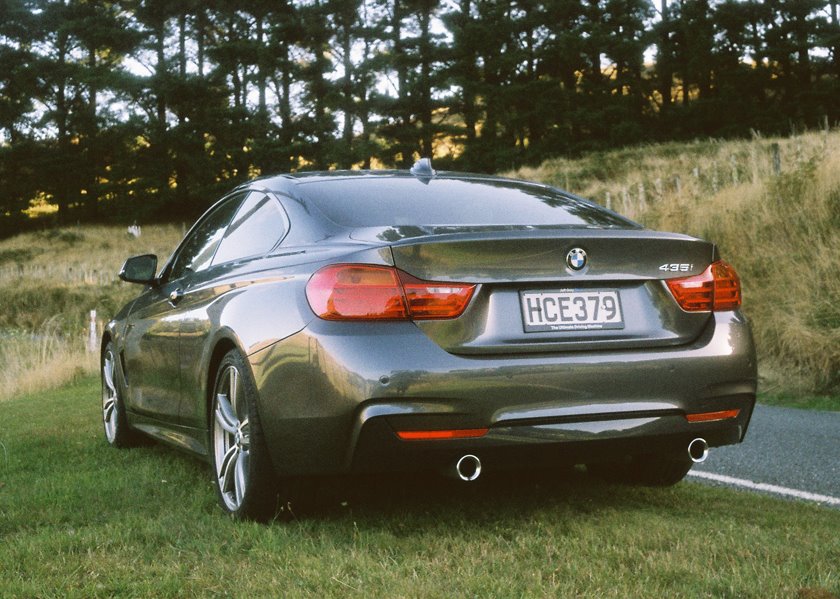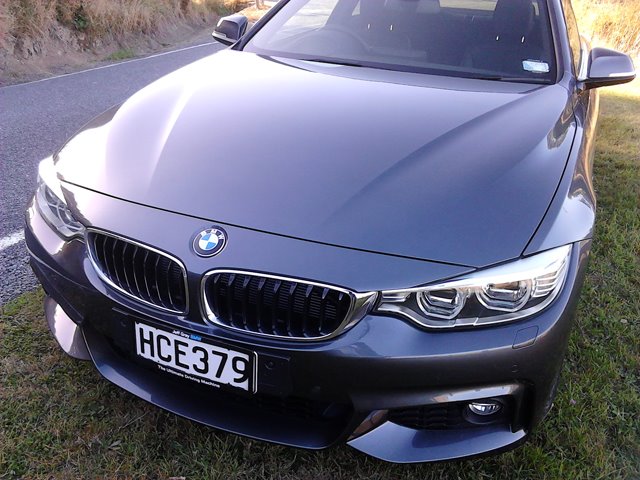


Stare-worthy The BMW 435i away from its natural environment of admirers and onlookers
Jack Yan is publisher of Lucire.
Jack Yan is surprised at the amount of people who use the BMW 435i M Sport as a conversation-starter
photographed by the author
In 17 years of this publication, we’ve driven some outstanding cars. There have been two Aston Martins, a Porsche 911, and two BMW X6s. And none of them have garnered the attention as the BMW 435i we tested.
It’s the one thing that has stuck with me during our week with the new coupé. The model line is new, although plans to create a coupé line of the 3-series wearing the 4-series moniker have been rumoured since 1978. (Whomever wrote that scoop in Motor, you were right.) But the 4 is an evolution of the 3-series coupé before it, admittedly with fewer restraints as BMW’s engineers and designers tried to distinguish its new line from the F30 3-series saloon from which it was derived. The wheelbase is longer than the outgoing 3-series coupé’s, and the front and rear track are wider.
It’s wider, lower and longer overall, meant to fulfil the task of the higher number assigned to it: be somewhere between a 3- and 5-series in the pecking order, and, in logical German fashion, ensure that we consumers understand that if the first digit is even, it denotes the sporting line—such as the 2-series (also new to the programme) and the 6-series (which is well established).
But being wider and lower shouldn’t raise eyebrows quite so easily. We had everyone come up for a closer look, be they a supermarket worker at Davis Trading, who said he came out to fetch trolleys (I’ve shopped there for years and that’s the first time anyone has bothered), or a homeless man on Cuba Street (he wasn’t interested in a hand-out—he just wanted to be in the presence of this car). We chatted about cars and he frankly talked about his alcoholism. The 435i made me approachable, not aloof. And that’s a good thing.
My chat to Jeff Gray BMW suggests that the car attracted attention because it was in reach of more punters: unlike the 650i, more buyers could see themselves take on the regular payments and own a 435i. It’s true that the NZ$126,900 base price for a 435i M Sport is far more attainable than the 650i Coupé at NZ$217,500, yet that doesn’t explain it fully, otherwise other cars in the same price bracket—such as the Lexus GS—would be getting the same attention. They don’t.
The BMW 435i first gets that attention because it’s hit that sweet spot of styling. It stirs all the right emotions, more than the company’s larger 6-series coupé. The long-bonnet, short-deck proportions, the wheels pushed out to each corner as far as possible—these are the classic ingredients for a sports car, but there is so much more in the 4er-Reihe’s 4·6 m length. It’s in the details: the creases on the bonnet that suggest power, the complexity of the M Sport-pack front spoiler that hints at aggression, the visual length of the car that softens both. Already you have tension in the design. The wide kidney grille has the proportions we have seen on BMW show cars and the electric i8 (more even numbers); the windscreen rake sends the same sporting message. The plastic vent in the wings just adds slightly more visual drama, and the surfacing on the doors builds on it—as the sun shines on the 435i, it looks complex enough for our eyes to want to savour all the details. If you want to pass by unnoticed, this is the car to avoid.
continued below



There’s just enough from BMW’s history in the design—the kidney grille and the Hofmeister-Knick are the obvious ones. However, the design cues all point to the future and the next generation of cars from the Müncheners, and that arguably makes it more exciting. People know what a BMW looks like, thanks to the plethora of decade-old 3ers on the road, but this goes one step further. BMW has shown before that you can keep tradition while indulging in new technology and looking to the next decade, with the E34 5-series of the late 1980s: to me, that remains the most elegant saloon model line from the company. The 4er-Reihe just might be the most elegant coupé line, taking what we know of the 6, and bridging it with what is to come from the i8.
Inside, the details continue to delight. The cabin is more driver-focused than the 3-series’, and even the switchgear reminds you that the 4 is a different model. The steering wheel controls are far more angular, though ergonomically, everything feels very comfortable. The wheel itself is probably the nicest to hold among the entire BMW range, both in terms of size and the leather used. You sit lower, as expected, while the impression—thanks to the linear design theme—is that the cabin is much wider. It’s not as cocooning as the 6-series’, but you feel very much “one” with the car, with supportive seats and BMW’s now very logical Idrive set-up. The assembly quality is top-notch, and everything feels satisfyingly well built. There’s nothing to be faulted and it shows how far BMW has come with its interiors in the last 15 years, taking the fight to Audi and surpassing the Ingolstadters’ A5, which is the 4’s natural rival. Thanks to the BMW’s rear-wheel-drive, it’s a considerably superior car to drive, and has a greater sense of immediacy than the Audi.
The straight-six, with its twin turbos, manages 306 PS, and the car delivers the power smoothly. It’s a very refined delivery—there’s little to upset the feeling of luxury inside—regardless of whether you’ve chosen the Sport, Comfort or Eco Pro modes. BMW claims 185 g/km of carbon dioxide emissions, which is more than respectable for a sports car, and in our drive, using a mixture of modes, we managed 30·4 mpg (Imperial) or 9.3 l/100 km. We made decent progress on the twisty roads around Eastbourne as the 435i gripped beautifully with well balanced handling, and the car acquitted itself on some of the Wellington region’s trickiest roads in Moonshine Valley and Riverton Terraces (where a good deal of the journey is single-lane, hilly, and with not much room to reverse should you need to give way).
Not that you would take it to Moonshine Valley too often. The 435i is designed to be stared at and appreciated, and it gives the driver an extra reward to know that they have been noticed and complimented. And, interestingly, never put down in the land of the tall poppy syndrome.
The fact that the BMW is also safe, relatively friendly on the environment, and has the twin-turbo performance to get you out of those difficult spots, do exceed the “look at me” factor: the 435i is an incredible daily proposition. But if you must attract those non-prejudicial, admiring glances, with the knowledge that it continues to remain less common than a Porsche 911 on New Zealand roads, then there’s little to beat the BMW. •





Related articles hand-picked by our editors
 The gentle touch
The gentle touch
Jack Yan lives with the BMW 320d Xdrive Touring Sport Line for an extended road test, and discovers that it keeps the Bavarians at the top of the class with an all-round, enjoyable package
photographed by the author on a Voigtländer Bessamatic Deluxe
 A cut above the rest
A cut above the rest
BMW’s 320i Edition 30 is one of three models commemorating the 30th anniversary of BMW New Zealand. Jack Yan drives the kitted-out Dreier
photographed by the author
 The spirit of 2002
The spirit of 2002
No, not the year: Jack Yan tries to find if any of BMW’s
diesel coupés recapture the essence of the company’s famed
2002 range of the 1970s
photographed by the author and Nigel Dunn
Advertisement
Copyright ©1997–2022 by JY&A Media, part of Jack Yan & Associates. All rights reserved. JY&A terms and conditions and privacy policy apply to viewing this site. All prices in US dollars except where indicated. Contact us here.